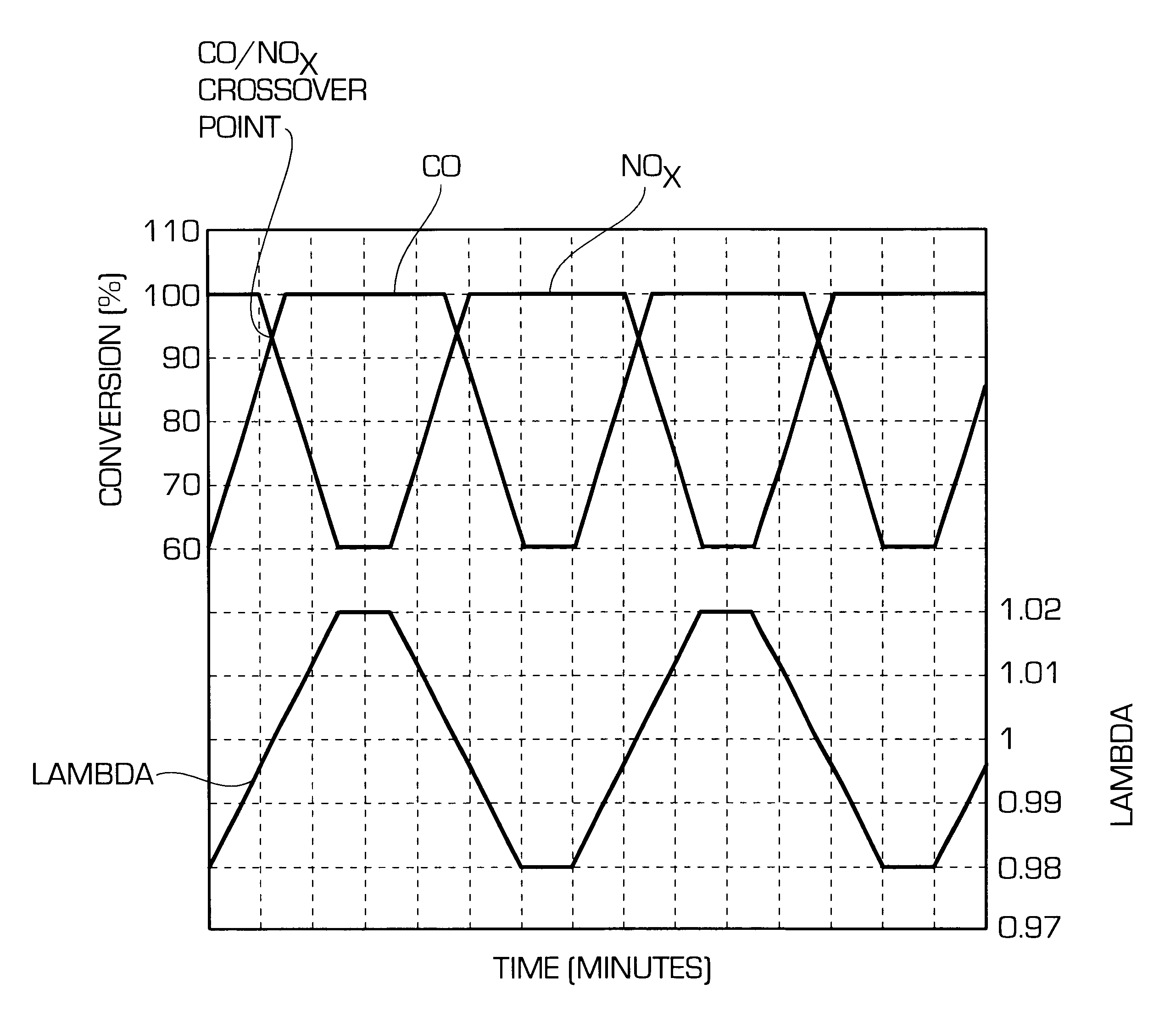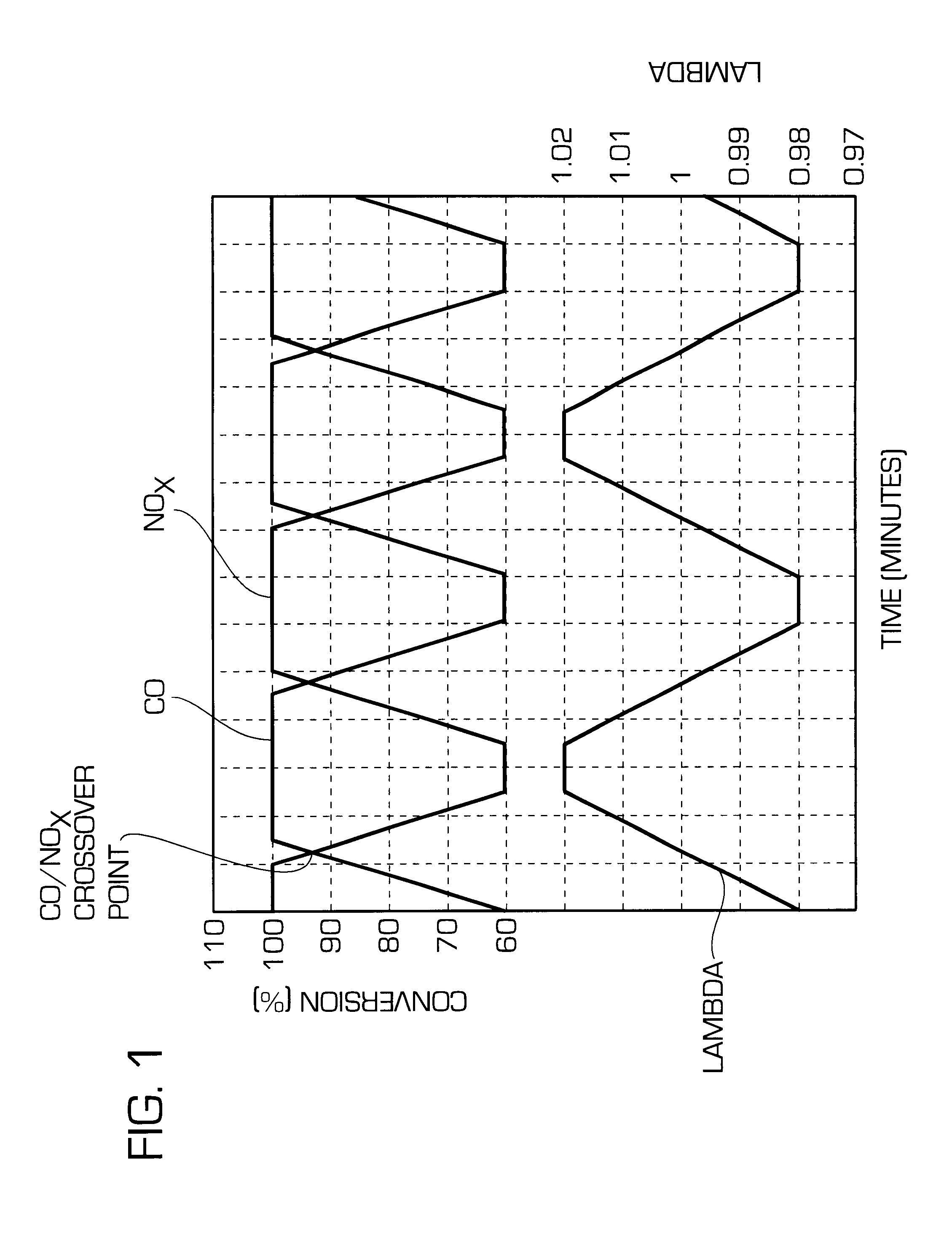Layered noble metal-containing exhaust gas catalyst and its preparation
a catalyst and noble metal technology, applied in the direction of metal/metal-oxide/metal-hydroxide catalysts, arsenic compounds, etc., can solve the problems of complex catalyst design, uncertain supply situation, rising prices,
- Summary
- Abstract
- Description
- Claims
- Application Information
AI Technical Summary
Benefits of technology
Problems solved by technology
Method used
Image
Examples
example 1
A double layer catalyst C1 according to the invention was prepared as follows:
Preparation of First (inner) Layer:
To a solution of praseodymium acetate, a cerium rich oxygen storage component (70 wt % ceria, 30 wt % zirconia) was added. By controlled injection of ammonia and stirring for about 30 minutes, praseodymium acetate was precipitated onto ceria / zirconia. Subsequently, stabilized alumina (3 wt-% La.sub.2 O.sub.3, 97 wt-% Al.sub.2 O.sub.3) and bulk zirconia were added. After this, a platinum solution ((EA).sub.2 Pt(OH).sub.6) was injected into the slurry and platinum was precipitated onto alumina and ceria / zirconia by proper adjustment of the pH-value of the dispersion with acetic acid. After milling the slurry, a monolithic carrier was dipped into the slurry to apply the first layer.
The complete washcoat uptake was 160 g / l. Finally, the first layer was dried and thereafter calcined in air at 500.degree. C.
Preparation of Second (outer) Layer:
Stabilized alumina (4 wt-% La.sub.2...
example 2
A further set of 4 different catalysts, C2, C3, C4 and C5, were prepared according to example 1. Differently from example 1, all catalysts were manufactured with a total noble metal loading of 2.12 g / l (60 g / ft.sup.3). The weight ratio of platinum to rhodium in the upper layer was varied to determine its influence on the catalytic properties of the catalysts. The noble metal distribution of these catalysts is listed in table 7.
Before determining the CO / NO.sub.x cross-over points, all four catalysts were aged for 12 hours at an exhaust gas temperature in front of the catalysts of 1100.degree. C. in a synthetic gas mixture of 6 vol.-% oxygen, 10 vol.-% water vapour, 20 ppm sulphur dioxide, balance nitrogen.
The static cross-over points of these catalysts were determined at an exhaust gas temperature of 400.degree. C. and a space velocity of 100000 h.sup.-1. During the test the lambda value of the exhaust gas was increased from 0.98 to 1.02 within 5 minutes. At 1.02 the lambda value was...
example 3
Two further catalysts, C6 and C7, with a total noble metal loading of 1.41 g / l (40 g / ft.sup.3), were prepared according to example 1. For the preparation of catalyst C6, example 1 was exactly duplicated, while for the preparation of catalyst C7 the sequence of platinum and rhodium impregnation for the second support was inverted. First, rhodium was deposited onto the activated alumina support and only thereafter platinum.
Both catalysts were tested for their CO / NO.sub.x cross-over behaviour and their light off temperatures. The results are given in table 9.
From the results of table 9 it can be seen that the dynamic behaviour of catalyst C6 is much better than that of C7. Without wanting to be bound by any theory, this effect may be explained by a more intimate contact between platinum and rhodium if platinum is deposited first and then rhodium.
PUM
| Property | Measurement | Unit |
|---|---|---|
| temperatures | aaaaa | aaaaa |
| crystallite sizes | aaaaa | aaaaa |
| crystallite sizes | aaaaa | aaaaa |
Abstract
Description
Claims
Application Information
 Login to View More
Login to View More - R&D
- Intellectual Property
- Life Sciences
- Materials
- Tech Scout
- Unparalleled Data Quality
- Higher Quality Content
- 60% Fewer Hallucinations
Browse by: Latest US Patents, China's latest patents, Technical Efficacy Thesaurus, Application Domain, Technology Topic, Popular Technical Reports.
© 2025 PatSnap. All rights reserved.Legal|Privacy policy|Modern Slavery Act Transparency Statement|Sitemap|About US| Contact US: help@patsnap.com


